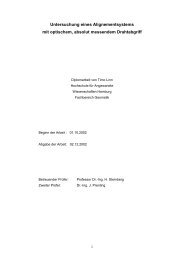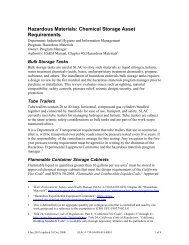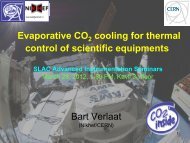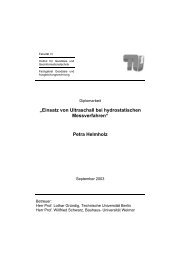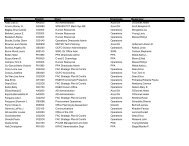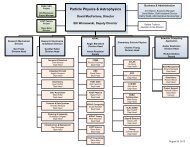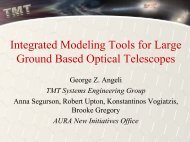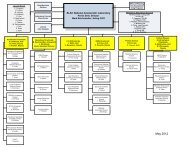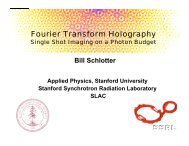BES - SLAC Group/Department Public Websites - Stanford University
BES - SLAC Group/Department Public Websites - Stanford University
BES - SLAC Group/Department Public Websites - Stanford University
Create successful ePaper yourself
Turn your PDF publications into a flip-book with our unique Google optimized e-Paper software.
Introduction<br />
FYO7 <strong>SLAC</strong> S CIENCE AND T ECHNOLOGY S ELF E VALUATION<br />
Leland <strong>Stanford</strong> Junior <strong>University</strong> (<strong>Stanford</strong> <strong>University</strong>) is under contract with the <strong>Department</strong> of Energy<br />
(DOE) to manage the <strong>Stanford</strong> Linear Accelerator Center (<strong>SLAC</strong>). Clause H.15 of Contract Number DE-<br />
AC02-76-SF00515 states that “performance-based management shall be the key enabling mechanism for<br />
establishing the DOE Contractor expectations on oversight and accountability.” Moreover, the specific<br />
mechanism for evaluating the performance-based approach (mission accomplishment, stewardship, and<br />
operational excellence) from October 1, 2006 to September 30, 2007 (fiscal year) is the FY07 Contractor<br />
Performance Evaluation and Measurement Plan (PEMP), which is organized by Performance Goals<br />
(Goals), Performance Objectives (Objectives), Performance Measures (Measures), and Performance<br />
Targets (Targets). The performance-based approach focuses on <strong>SLAC</strong>’s performance against these<br />
Goals. The DOE Office of Science (SC) mandates that each SC Laboratory establish the same eight goals<br />
in the PEMP. The eight goals are:<br />
Provide for Efficient and Effective Mission Accomplishment<br />
Provide for Efficient and Effective Design, Fabrication, Construction and Operations of Research<br />
Facilities<br />
Provide Effective and Efficient Science and Technology Program Management<br />
Provide Sound and Complete Leadership and Stewardship of the Laboratory<br />
Sustain Excellence and Enhance Effectiveness of Integrated Safety, Health, and Environmental<br />
Protection<br />
Deliver Efficient, Effective, and Responsive Business Systems and Resources that Enable the<br />
Successful Achievement of the Laboratory Mission(s)<br />
Sustain Excellence in Operating, Maintaining, and Renewing the Facility and Infrastructure<br />
Portfolio to Meet Laboratory Needs<br />
Sustain and Enhance the Effectiveness of Integrated Safeguard and Security Management<br />
(ISSM) and Emergency Management Systems<br />
SC also requires each SC Laboratory to use the same Objectives to measure progress against the Goals.<br />
This document reports <strong>SLAC</strong>’s success in achieving the three science and technology (S&T) Goals<br />
(Goals 1 through 3) and Objectives. The report also incorporates performance outside of the specific<br />
Goals and Objectives, including identifying key achievements and opportunities for improvement.<br />
Executive Summary<br />
The <strong>SLAC</strong> Mission, which articulates the Vision for the Laboratory, has three components:<br />
To make discoveries in photon science at the frontiers of the ultrasmall and the ultrafast in a<br />
wide spectrum of physical and life sciences,<br />
To make discoveries in particle physics and astrophysics to redefine humanity’s understanding of<br />
what the universe is made of and the forces that control it, and<br />
To operate a safe laboratory that employs and trains the best and the brightest, helping to ensure<br />
the future economic strength and security of the nation.<br />
This mission did not change from FY06 to FY07.<br />
The following sections describe the work at <strong>SLAC</strong> in more detail, highlighting the accomplishments<br />
made during the past FY07.<br />
As will be detailed below, <strong>SLAC</strong> did well in the accomplishment of the science mission, exceeding<br />
expectation both in the impact of results on the field and in the quality of the leadership provided. The<br />
recognition of the work of long time SSRL user, Roger Kornberg, with a Nobel Prize certainly was the<br />
most outstanding measure of scientific accomplishment at the Laboratory. However, another important<br />
example has been the impact of the D mixing result from BABAR on our understanding of models for new<br />
physics at the TeV scale.<br />
F I N A L P A G E 1



